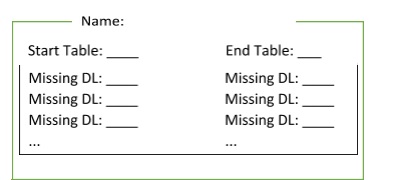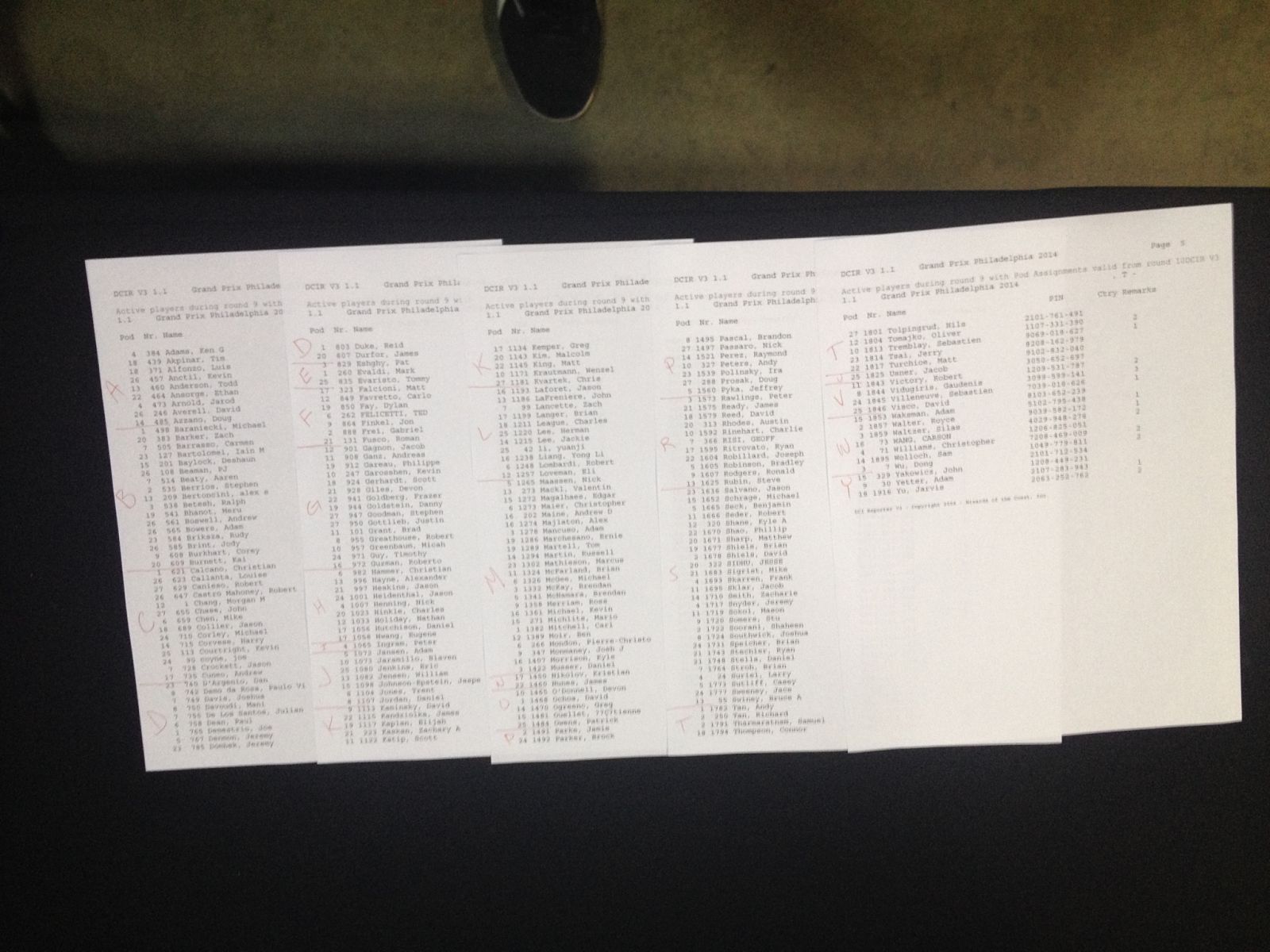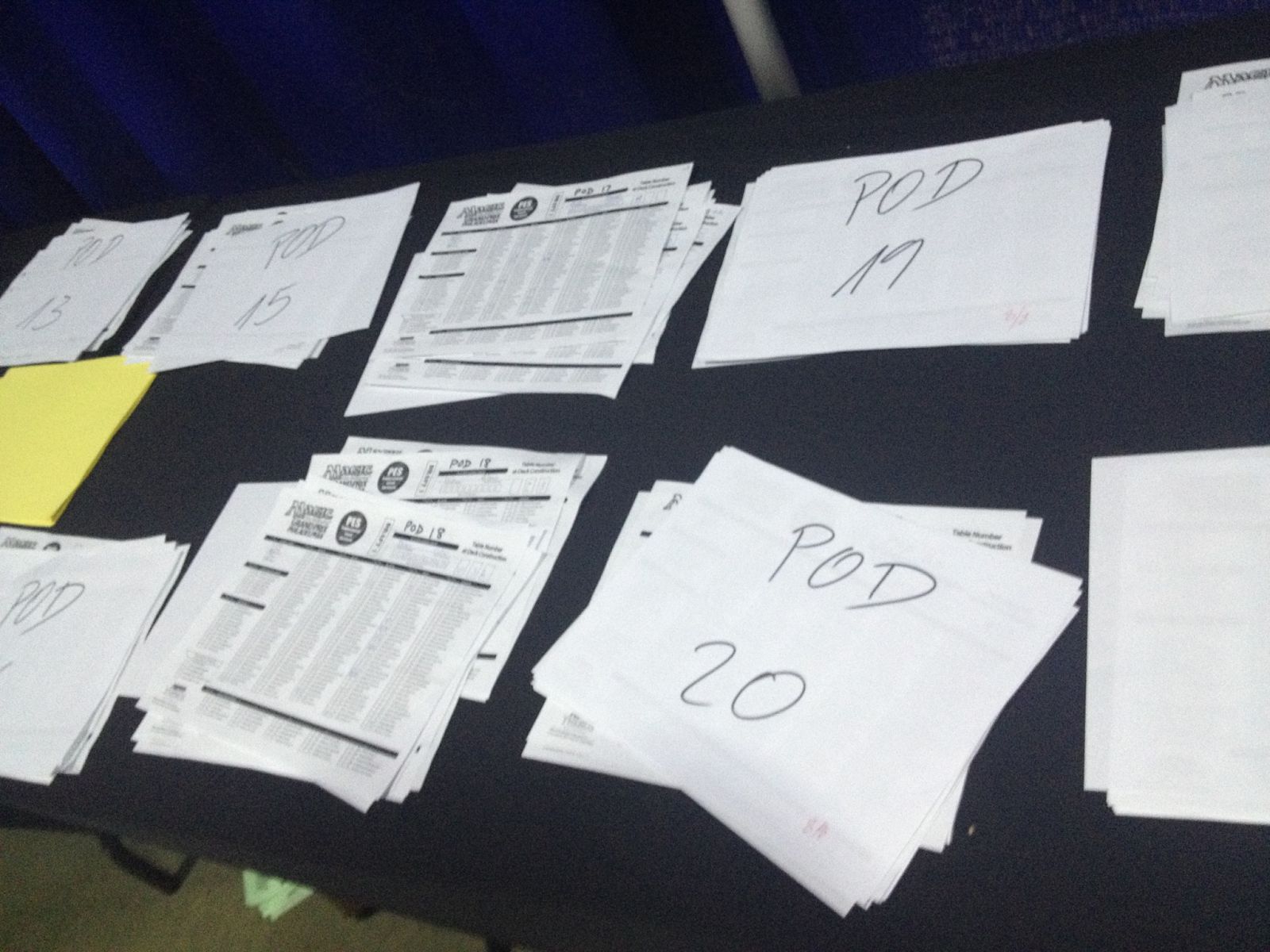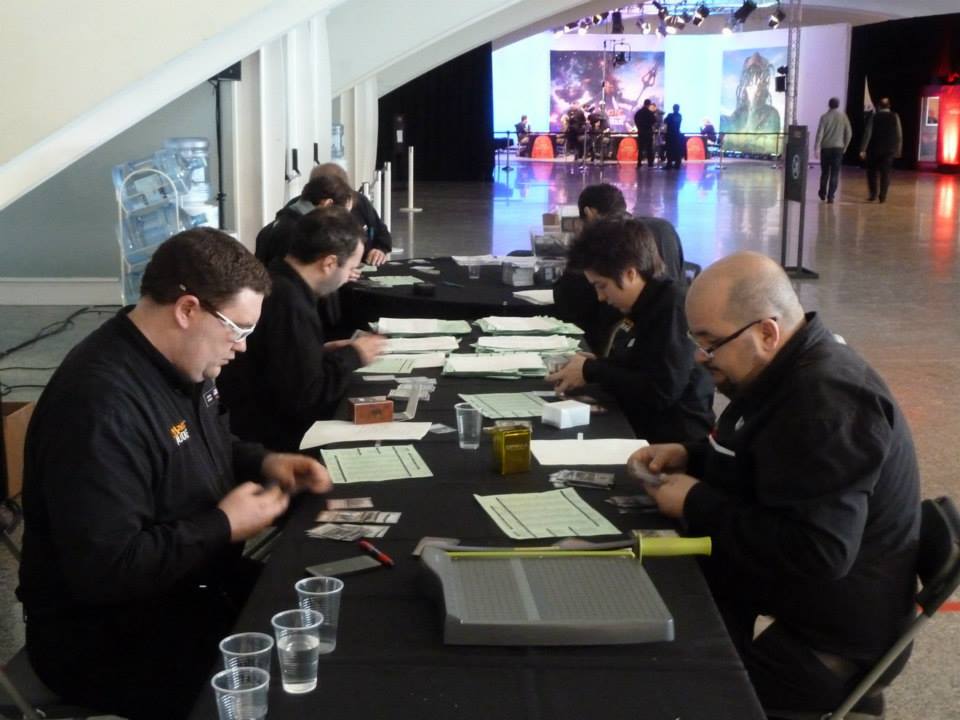At Competitive and Professional REL events we require players to fill out a decklist before they start playing. This allows judges to verify players are playing what they planned to, haven’t modified it during the tournament, and didn’t use any illegal cards.
As with any team or task it’s much more straightforward at a GPT, than at a PTQ, than at a Grand Prix. As the event grows, so does the potential complexity of how we run Deck Checks. Just remember that the same basics can be used at any event, both limited and constructed. In this article we will focus on how the Deck Check team work at a Grand Prix.
The goals and tasks of the Deck Check team
- Ensure every player has handed in his or her decklist: For this we need to account for all decklists against the master list as soon as possible. This is the top priority at the beginning of the day for the Deck Check team.
- Deter players from altering their decks: This is done by doing deck checks as early as the beginning of round 1.
- Maintain a strong presence on the floor: Floor coverage serves all players and the deck check team needs to play a role here as well.
- Provide players the appropriate customer service if they need to verify their decklists: We want players to come to us and verify their decklists if they need to, rather than get exposed to potential problems.
- Verify legality of decklists: Counting happens throughout the day, when time and resources permit.
- Issue the appropriate penalties for any Deck/Decklist Problem infraction: Penalties are issued throughout the day, at the beginning of the round following the discovery of the infraction. This includes any round of the event, including the Top 8.
Besides these, the tasks of the Deck Check team are then somewhat repetitive:
- Select some tables randomly
- Pull decklists out
- Collect the decks at the selected tables
- Check and return the decks
The optimization of the process doesn’t really need all the lists to be sorted alphabetically. This is highly time and resource consuming. What is really needed is to be able to pull one or more specific lists out of the piles and return them to their correct place as efficiently as possible. The following describes how to do exactly that; it doesn’t change anything about the priorities of the Deck Check team, the timing of when to count lists or when and how to do deck checks.
Preparing for Day One
Before the event starts you should find your deck checks area. This is where you will sort, check, and work with decklists. Typically this is planned for by the Tournament Organizer and Head Judge in advance, so work with them to find out where it is. If nothing has been planned, coordinate with the Logistics Team to find a place that you can call home for the day. You will need some tables, chairs for each member of your team and some method to orderly store and/or file your decklists.
For Decklist counting we are now working under a new philosophy, as outlined by L5 Kevin Desprez in this article: Lowering Priority on Decklists Counting
During your Team Meeting you should review your expectations and plans. This is the perfect moment to instruct your team on the new philosophy. You should also brief your team on other specifics, such as details on how to handle decklists (how and where to note a correct list, how to note problems and where to put illegal lists, etc.) and how to collect decklists. This task can make or break the day for the team, so having a clear idea on what to do and how to do it will help everyone be on track for the whole day.
Collecting decklists
Constructed Events
As Deck Checks Lead you will need to review the layout of the room and assign table ranges for judges to collect decklists from players. Typically you will be able to recruit judges from other teams to expedite collection. You should gather all the team leads involved in the collection and assign table ranges handing them the collection result papers (see below), letting them brief their team about the details for decklist collection. This is a great time to ensure that all judges will look at decklists when they get turned in to confirm that the player’s name/DCI number and their table number are on their decklists.
The collectors should each have a sheet of paper with:
- Their name on it (for clarification if needed later).
- Table ranges (this can be filled by the collector just before he hands out his stack).
- Missing decklists table numbers (this can be filled by the collector as he goes through the row).
- The order the decklist should be collected “Lowest on top” or some similar method.
This will allow the sorting team to know where missing decklists are located and they will not have to count everything again. The same method can be used for the waiver forms collection.

Late arrivals will hand their decklist to the Deck Check team and will be integrated to the different piles and their missing decklist will then be crossed over to show that it was found.
For Sleep-ins and VIPs the TO is typically the one getting all decklists from those players skipping the player meeting. The TO should print these decklists out and hand them over to the Deck Check team as soon as possible. The Scorekeeper should also prepare a list of all VIPs and Sleep-Ins for the Deck Check team with fictional table numbers in another range than the table numbers of the “normal” players and the Deck Check team will then write down the table numbers on the decklists.
Limited Events
At a Limited Event we won’t be able to collect decklists during the player meeting, as the players haven’t built their decks yet. Most judges will be on the floor during the build phase and may collect decklists. This will result in more effort for the Deck Check team as sorting all decklists by table number is needed, so extra coordination should come into place. Ideally judges should be assigned zones on the floor to be in as players will call for a judge when they are done registering their deck and should only collect from those zones. The “missing decklist” can also be pre filled during construction as the player is missing from his seat during construction. Again you should ensure all judges on the floor know that they should confirm the Player Playing Deck field is filled in; the table number they built at is written down; the player has listed played basic lands; and something has been registered as “played” in the decklist.
Collecting decklists for VIPs and Sleep-Ins
There are two way to collect the decklists of the VIPs and Sleep-Ins:
1. Set time for building and collection
The VIPs and Sleep-Ins come at fixed times to build their decks. In order to provide the best possible customer service it’s important to adapt to players arriving before their scheduled time. A good practice is start register/build sessions every 15 minutes.
2. Players come and build
The VIPs and Sleep-Ins come whenever they want (depending of course on the number of byes they have) and start building their decks. The VIP team handling their decklist will collect them and bring a pile to the Deck Check team each round. The Deck Check team will then use the VIP / Sleep-In list to write the correct number on each list.
Sorting decklists
At this point the Deck Check team should start sorting decklists by table number in piles of a manageable size (50 decklists, for example).
A key aspect to this procedures is that the HJ should ask the players during the player meeting (after the deck swap for Limited GPs) to write their table number on the decklist. This will facilitate further procedures: it’s more intuitive to sort numbers than letters, and it’s also more intuitive to search for number than letters. Players write numbers more legibly than their own names most of the time. It’s sometimes very difficult to find if a specific name is the correct one because it’s just not readable. In some countries players often swap first name and last name, which makes everything even harder. Numbers, on the other hand are easier to interpret. Besides, this allows us to avoid problems in regions where there are plenty of similar names (“Van…” in the Netherlands, “Smith” in the US, or “García” in Spain).
A sheet of paper should be placed on all piles with the range of tables and a listing of missing decklists for easier control similar to the one used to collect lists. Then checking against the master list is then just a question of which player is missing between two numbers and can be done very efficiently. Stragglers allowed to join the event will hand their decklist to the Deck Check team to integrate them in their pile using their original table number.
The Index
Currently, the biggest problem at GPs is having a lot of different alphabetically sorted player lists available:
- Offline registration (“normal” players)
- Sleep-Ins and VIPs
- Late arrivals or players with wrong name / DCI number registered
- Online registration (grouped together because of the papers they needed to sign)
The number of online registration keeps growing and the trend seems to indicate that the percentage will grow even higher next year. The Sleep-Ins and VIPs are not sorted or numbered during collection and their number, if not limited by the TO, seems to be rising as well. Using different piles to store the different decklists without caring about the alphabetical order seems to be easier than trying to merge all different piles into the alphabetically sorted fans.
The VIPs (if they have byes) and Sleep-Ins also have to be removed from the seat all and another one has to be created for them. Scorekeepers are DCIR and Excel magicians and they surely always deliver, but in the process they create different lists for each group of players. The VIPs and Sleep-Ins are renamed to show their status using a “zzzzVIP” or “zzzzSI” before their name. The different lists have to be printed and handed to the Deck Check team to make sure they have all the lists and can check who is missing.
To be able to find a player quickly and efficiently, a consolidated seat all, which we call the Index, will have to be printed. The Index is a list of all players without their status (“zzzzVIP”, etc) sorted alphabetically and comprising all players active in the tournament. While adding an extra step to the search for decklists sounds like a complication in the process, it is actually an approach that simplifies the workflow as a whole, since referring to a table of content is something humans already do often in daily life.
Coverage can access lists through the Index more easily than spending a lot of time going through the folders, and the Index allows concurrent uses (multiple copies, posted on the wall).
On top of that, alphabetical Seat-All might be useful for collecting decklists but can lead to collusion between family members at limited events. If desired, the Index allows for a random Seat-All and removes the problem while still getting the benefits.
Having the byes in the Index allows judges to know in advance if a player can be found, if his list is missing or if there is a problem during counting.
The Deck Check team can then start sorting the decklists of the VIPs and Sleep-Ins even before the tournament has started as the number is on the sheets and can be used for sorting (for constructed at least). Receiving the Index during the player meeting will allow a few judges to start going through the decklists to find missing ones. If space allows it, the different piles of decklists could be left as they were collected with the summary sheet on top. If there isn’t enough space for them, they could be inserted into a folder in piles of 50 (24 or 25 tables).
Example of an Index Day 1
|
TABLE |
LASTNAME |
NAME |
BYES |
|
231 |
Artest |
Ron |
2 |
|
… |
… |
… |
… |
|
766 |
Bryant |
Kobe |
1 |
|
… |
… |
… |
… |
|
2017 |
Gallinari |
Danilo |
|
|
… |
… |
… |
… |
|
31 |
Rose |
Derrik |
2 |
|
… |
… |
… |
… |
- Gallinari is a VIP (+2000)
- Bryant was late and had to sit at the end of the tournament (766)
Example of an Index Draft Day 2
|
POD |
LAST NAME |
FIRST NAME |
|
1 |
Artest |
Ron |
|
8 |
Bryant |
Kobe |
|
… |
… |
… |
|
3 |
Gallinari |
Danilo |
|
… |
… |
… |
|
6 |
Rose |
Derrik |
|
… |
… |
… |

Detecting missing decklists
When all decklists have been collected, the different Seat-Alls are used to check if all decklists have been collected and whose decklists are missing. The idea here is to not check all decklists against a Master List but only the ones shown in the summary on top of the piles, as they have already been checked by the collector judge. We only need to know which one of the two players using the same table number has a missing decklist.
Day Two
The scale of operations will significantly get reduced for day two. Note you will be using a new index with the active players after the day one cut.
Limited
The procedure consists on sorting by pod, rather than by name.

To make the sorting and deck checking of the draft portion faster, we will use the same technique of the Index (see above) and not sorting the list alphabetically. The deck check team has to prepare two sets of decklists (one for each draft) with the Pod and draft number written on them (8x “Draft 1 / Pod 1”, 8x “Draft 1 / Pod 2”, etc) and have them distributed to all participant after they have finished drafting but before they are allowed to go to their construction table.
Adam Cetnerowski described this procedure in deeper detail in his article- The Pod People
Constructed
It’s a good practice to pull out the decklists of those players who advance to Day Two after the Day One cut. It’s likely that not all those decklists will be counted at that point, so it’s important to verify with your HJ on how much counting should be done on those decklists.
Doing Deck Checks
For both days the Index should be taped to a wall or laid out on a table for reference. When the round starts and the random table numbers come, or when a team comes with two decks during a mid-round deck check, one judge will take the result slip (or the random table number list), look the name of the players in the Index and take the list in the pile containing the corresponding table number. This process is a lot faster than taking the pile of lists starting with the same letter as a player and searching through it for the correct list.

When a list is found and taken out of the pile, a colored paper or some sort of indicator is put in its place. This ensures the team always knows if a decklist has been taken (either by a judge or by the coverage team) and is not missing.
Generic Guidelines
It’s important to delegate appropriately, and not attempt to do everything on your own. Being a Team Lead is about overseeing and coordinating with your team to get the job done. Identify times when your team won’t have support from other teams, and times when you can pool resources with other teams. Adapt and coordinate with other Team Leads accordingly.
Remember the key for the Deck Check team is to maintain an adequate floor presence. To achieve that equilibrium you’ll need to make sure your resources are correctly balanced between decklist sorting and counting, actual deck checking, and floor coverage.
For more information about team leading and how teams interact:
